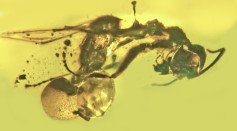ants
Ant Social Parasitism: Plot Twists in the Origins and Evolution of These Tiny Animals Revealed
Ant Teeth: Scientists Reveal How They Can Help in the Development of Gadgets
Alvarezsaurs Dinosaur Shrank from Large Turkey to Chicken Size 100 Million Years Ago Due to Termite Diet

Parasitic Fungus Grows Out 50-Million-Year-Old Fossilized Ant's Rectum
Giant Sea Anemone Also Eats Ants, Spiders: How Did These Insects Reach the Sea?
Fire Ants May Have Driven Spiders Away, Research Says
Indian Jumping Ants Shrink, Regrow Their Brains to Become Queen of the Colony
Leaf Cutter Ants Evolved a Biomineral Armor That Protects It From Pathogens
Why Zombie Ants Do That Thing They Do
'Yellow Crazy Ant' Uniquely Provide Foods For The Colony's Larvae, Through Laying Eggs
Scientists Use Hydrogels To Control Invasive Argentine Ants
Ants Do Not Eat Leaves: They Use Them To Grow Fungus Garden For Food And Space
Ants Can Change Their Roles In Their Colony -- Study
The Foodies Beneath Our Feet—Urban Ants Like Human Food Too
Most Popular

How Technology Is Changing the Real Estate Industry?

AI Revolution in Medical Education: Transforming How Healthcare Professionals Learn

Zombie Star Set to Light Up Night Sky: Blaze Star Could Erupt Soon

Exploring Life Beyond Earth: Study Claims Other Planets Could Be Suitable for Alien Life





